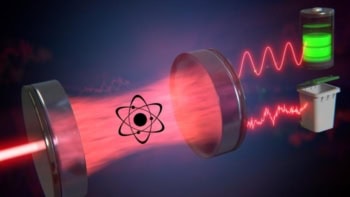New analysis of the cosmic microwave background - the cool remnant of the radiation that filled the early Universe - has provided further evidence for the inflationary Big Bang model. The sizes of temperature fluctuations in the microwave background are consistent with the theoretically predicted variations in density that would result from a rapid expansion of the early Universe. The findings, which were presented last week at a meeting of the American Physical Society in Washington DC, came from three experimental collaborations called Boomerang, Maxima and DASI. They show that there is a series of preferred scales over which the temperature fluctuations occur.

According to inflation theory, the early Universe underwent a period of exponential expansion for a few fractions of a second. This turned quantum fluctuations into the density variations that led to structure in the Universe, setting up sound waves that produced the ripples in the microwave radiation. An analysis of the Boomerang data that was published last year confirmed the presence of the largest ripples, which extend about a degree across the sky and provide convincing evidence that the overall geometry of the Universe is “flat”. But there was no firm evidence for higher “harmonics” – the ripples that are predicted to occur at smaller angular scales. In contrast the new analysis finds these harmonics peak at the angles predicted by inflation theory.
The ratio of the heights of the first and second peaks is a measure of the amount of ordinary, or “baryonic” matter in the Universe. The new data indicate that ordinary matter accounts for about 4.5% of the Universe’s total mass and energy. Unlike last year’s analysis, which suggested 6%, the new figure agrees with an estimate of the amount of ordinary matter in the Universe, based on calculating the quantities of deuterium produced in the Big Bang.
“These results are a tremendous confirmation of the inflationary model and also agree extremely well with measurements by other astronomers using completely different methods. It looks like we now have a ‘Standard Model of Cosmology,'” says Phil Mauskopf from Cardiff University, a member of the Boomerang collaboration.
The Boomerang experiment, which took its data from a telescope suspended from a balloon high above the Antarctic, involves physicists from Canada, Italy, the UK and the US. The Dasi and Maxima experiments, on the other hand, are purely American collaborations. Dasi is a ground-based experiment located at an observatory at the South Pole and Maxima another balloon experiment.
At the end of June, NASA’s MAP satellite is due to take off. This will take far more detailed images of the microwave radiation than previous experiments – it will be some 100 times more accurate and will study the whole sky (Boomerang, in comparison, covered only about 3% of the sky). And it will also measure the polarization of the radiation. Since different theories of the Universe’s origins predict different polarization patterns, MAP will provide an additional check on the validity of inflation theory.



